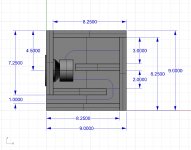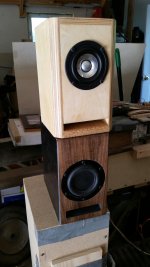I purchased a few of these drivers recently and put one in a small TL enclosure. I attached a drawing of the enclosure. I'm very happy with this set-up. Now I'd like to try something a little different. I want to put four of these drivers in a TL. Can anyone help me with the enclosure? If I'd "unfold" the one in the attached drawing, would I enlarge the cross-section 4 times? And the port 4 times larger? I know the length stays the same, but I'm not sure about the rest of the dimensions.
I'm also open to other ideas, as long as I'm using this driver.
Does anyone know whose design this is? I pulled it off the forum a while back, but I can't find it now.
Thanks,
Mike
Tectonic Elements TEBM65C20F-8 3-1/2" BMR Full-Range Speaker 8 Ohm
I'm also open to other ideas, as long as I'm using this driver.
Does anyone know whose design this is? I pulled it off the forum a while back, but I can't find it now.
Thanks,
Mike
Tectonic Elements TEBM65C20F-8 3-1/2" BMR Full-Range Speaker 8 Ohm
Attachments
I would advice you this type of BR-enclosure for the BMRs: Beeper Bausatz im Angebot bei SpectrumAudio-Spezialvertrieb für Breitbandlautsprecher und mehr
I tried a TML but I haven't been satisfied. The maximum cone-movement appeared very early in my straight line...
I tried a TML but I haven't been satisfied. The maximum cone-movement appeared very early in my straight line...
Can I ask why you want four of them? You will get an increase in sensitivity but you get some lobing at close range. If you have four, I would go with a bi-pole with two front firing and two rear firing. I would make a MLTL very much like this one http://www.diyaudio.com/forums/full-range/234535-tangband-w3-881-mltl-build.html. The advantage is that you don't have the baffle step loss with a bipole and it will make the speaker have additional bass capability for free. You cannot use it near a wall though - at least 3 ft away. So the MLTL would be a tower speaker. Is that OK or are you looking for a folded compact "bookshelf format" ? If so, 4 drivers kind of ruins that. This would be pretty easy to sim as a MLTL or if you are adventurous try the AMLTL technique http://www.diyaudio.com/forums/full-range/231951-accidental-mltl-technique.html . Should work well in this case. If the tower bipole is something you like I can run a sim and design for you.
Last edited:
Can I ask why you want four of them? You will get an increase in sensitivity but you get some lobing at close range. If you have four, I would go with a bi-pole with two front firing and two rear firing. I would make a MLTL very much like this one http://www.diyaudio.com/forums/full-range/234535-tangband-w3-881-mltl-build.html. The advantage is that you don't have the baffle step loss with a bipole and it will make the speaker have additional bass capability for free. You cannot use it near a wall though - at least 3 ft away. So the MLTL would be a tower speaker. Is that OK or are you looking for a folded compact "bookshelf format" ? If so, 4 drivers kind of ruins that. This would be pretty easy to sim as a MLTL or if you are adventurous try the AMLTL technique http://www.diyaudio.com/forums/full-range/231951-accidental-mltl-technique.html . Should work well in this case. If the tower bipole is something you like I can run a sim and design for you.
Thanks X,
No particular reason for four. It's just a starting point. I had thought about the bi-pole. Maybe eve just go with two per cabinet. I was thinking of crossing just before the notch shown on the manufacturer's spec sheet.
http://www.parts-express.com/pedocs/specs/297-2156--hibm65c20f-8-data-sheet.pdf
I would like to use a full-range since I'll be crossing a little low; ~1500Hz. I have a few of the Fountek FE83's and a few Tang-Band W3-881si's. I like the sound when combined with the Fountek. It adds a little "sparkle." I also have a few other 3 inch full range drivers. I like the MLTL you linked. I've also given some thought to a TABAQ (doubled for 2 drivers).
At any rate, I'm in the thinking stage. More suggestions are most appreciated.
Thanks,
Mike
Attachments
How did you manage the phase wrap and chasm in the FR at 1.2kHz?
I didn't yet. I was thinking of crossing to another full-range driver before the chasm. However, I haven't noticed the chasm to be audible. Maybe once it's addressed, it'll be obvious it's there.
As far as phase wrap, I must claim ignorance. Can you explain phase wrap?
Thanks,
Mike
With any large dip in the response, the driver's output will have a non flat response in phase. With a full range driver, one of the main advantages is that is has a flat phase response over the main mid to HF bandwidth region of 400Hz to 6kHz. If phase is flat, the soundstage and imaging is very good. It's more important for stereo mic'd small ensembles rather than multi mic recorded and post processed recordings. Some people claim phase doesn't matter and go about using multiway speakers with 2nd and 4th order XO's all over the place (they have phase wrap). Trick is to put phase wrap at spot less critical to spatial location. 1kHz to 3khz is probably most critical range to keep phase flat. It's a minor point but should be avoided if possible.
I am doing some initial sims of these BMR drivers. Thy are terribly inefficient. Are you sure you want to use them? With the TS params I have even four drivers in series parallel barely breaks above 86dB sensitivity. You might as well use a good 87dB sensitive full range or two to get way higher sensitivity.
I am doing some initial sims of these BMR drivers. Thy are terribly inefficient. Are you sure you want to use them? With the TS params I have even four drivers in series parallel barely breaks above 86dB sensitivity. You might as well use a good 87dB sensitive full range or two to get way higher sensitivity.
Last edited:
With any large dip in the response, the driver's output will have a non flat response in phase. With a full range driver, one of the main advantages is that is has a flat phase response over the main mid to HF bandwidth region of 400Hz to 6kHz. If phase is flat, the soundstage and imaging is very good. It's more important for stereo mic'd small ensembles rather than multi mic recorded and post processed recordings. Some people claim phase doesn't matter and go about using multiway speakers with 2nd and 4th order XO's all over the place (they have phase wrap). Trick is to put phase wrap at spot less critical to spatial location. 1kHz to 3khz is probably most critical range to keep phase flat. It's a minor point but should be avoided if possible.
I am doing some initial sims of these BMR drivers. Thy are terribly inefficient. Are you sure you want to use them? With the TS params I have even four drivers in series parallel barely breaks above 86dB sensitivity. You might as well use a good 87dB sensitive full range or two to get way higher sensitivity.
Thanks X,
I think I do want to use them. I like the low end for such a small speaker. I have given a bit of thought to the TC9, but it doesn't appear to go as low. I don't mind the low sensitivity.
In light of your first paragraph, crossing near the dip will through off the phase? You mentioned a 2nd and 4th order crossover. Will a 1st or 3rd order cause less of an impact?
Thanks again for your help.
Mike
this looks like a quarter wave pipe, but i wont say its Quarter wave transmission line as the line length has to be 35inchesI purchased a few of these drivers recently and put one in a small TL enclosure. I attached a drawing of the enclosure. I'm very happy with this set-up. Now I'd like to try something a little different. I want to put four of these drivers in a TL. Can anyone help me with the enclosure? If I'd "unfold" the one in the attached drawing, would I enlarge the cross-section 4 times? And the port 4 times larger? I know the length stays the same, but I'm not sure about the rest of the dimensions.
I'm also open to other ideas, as long as I'm using this driver.
Does anyone know whose design this is? I pulled it off the forum a while back, but I can't find it now.
Thanks,
Mike
Tectonic Elements TEBM65C20F-8 3-1/2" BMR Full-Range Speaker 8 Ohm
but still nice design none the less for compact space
Since when did it 'have' to be 35in? 😕
Are you assuming that to be defined as a transmission line, the pipe must be physically 1/4 wave of Fs? If so, that is not the case I'm afraid. For a start, there is no formal definition for an acoustic transmission line -it's become (for better or worse) an alternate / synonym for most forms of quarter-wave pipe. Secondly, the resonant frequency of a pipe is a function of both physical length and taper, not just axial length, and you also have to factor end-correction into that as well.
If you want a max-flat impedance pipe, i.e. one which would provide the flattest impedance load, then tuning to Fs is OK, but typically you'd tune higher to achieve that.
Are you assuming that to be defined as a transmission line, the pipe must be physically 1/4 wave of Fs? If so, that is not the case I'm afraid. For a start, there is no formal definition for an acoustic transmission line -it's become (for better or worse) an alternate / synonym for most forms of quarter-wave pipe. Secondly, the resonant frequency of a pipe is a function of both physical length and taper, not just axial length, and you also have to factor end-correction into that as well.
If you want a max-flat impedance pipe, i.e. one which would provide the flattest impedance load, then tuning to Fs is OK, but typically you'd tune higher to achieve that.
Last edited:
- Home
- Loudspeakers
- Full Range
- 4 X Tectonic BMR in a TL?

